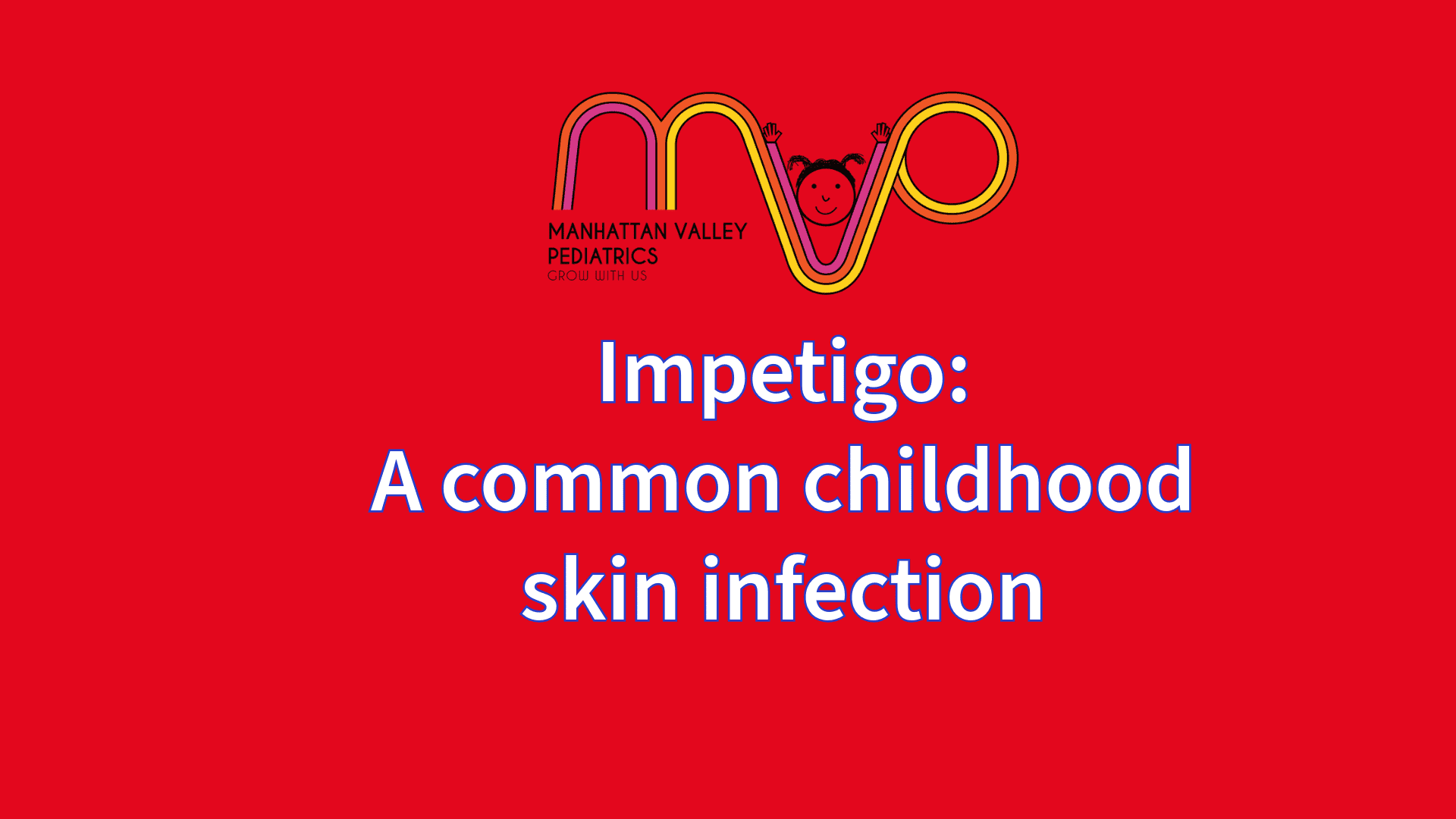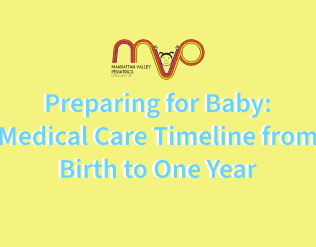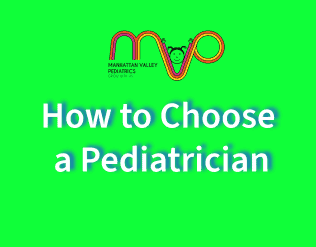Impetigo: A Parent’s Guide to This Common Childhood Skin Infection
By Manhattan Valley Pediatrics Staff
As a busy pediatrics practice, we see impetigo regularly, and we understand how concerning it can be when you first notice those distinctive honey-colored crusts on your child’s skin. The good news? While impetigo is highly contagious, it’s treatable and rarely causes serious complications when properly managed. Let’s discuss everything you need to know about this common childhood infection.
What Is Impetigo?
Impetigo is a superficial bacterial skin infection that primarily affects the outer layer of skin called the epidermis. It’s incredibly common, accounting for approximately 10% of all skin problems I see in pediatric clinics. Two types of bacteria most frequently cause the infection: Staphylococcus aureus (staph) and Streptococcus pyogenes (group A strep).
Think of impetigo as an opportunistic infection—it typically occurs when bacteria enter through small breaks in the skin, such as cuts, insect bites, or areas irritated by conditions like eczema.
Who Gets Impetigo?
While anyone can develop impetigo, it’s most common in children between 2 and 5 years old. There are several reasons why young children are particularly susceptible:
- Active play: Outdoor activities often lead to minor cuts and scrapes
- Close contact: Daycare and school settings facilitate person-to-person transmission
- Developing hygiene habits: Young children are still learning proper hand washing techniques
- Sensitive skin: Children’s skin barriers are more easily compromised
Recognizing the Signs and Symptoms
Impetigo typically appears about 10 days after exposure to the bacteria. As a parent, here’s what to watch for:
Non-Bullous Impetigo (Most Common – 70% of cases)
- Small red bumps or tiny fluid-filled blisters that quickly burst
- Characteristic honey-colored or golden-yellow crusts that form over the sores
- Lesions that are itchy but generally not painful
- Most commonly appears around the nose, mouth, face, arms, and legs
Bullous Impetigo (30% of cases)
- Large, fluid-filled blisters that may remain intact for days
- When blisters burst, they leave raw, red areas that form crusts
- More common in infants and children under 2 years
- Often affects the trunk, arms, and legs
How Does Impetigo Spread?
Understanding how impetigo spreads helps you protect your family and community. The infection is highly contagious and spreads through:
- Direct contact with infected skin or drainage from sores
- Contaminated objects like towels, clothing, toys, or sports equipment
- Poor hygiene practices, particularly inadequate handwashing
The bacteria are particularly good at surviving on surfaces, which is why proper cleaning and isolation measures are so important.
When to See Your Pediatrician
Contact your child’s doctor if you notice:
- Red, oozing sores with honey-colored crusts
- Spreading infection despite home care
- Signs of deeper infection (increased pain, redness, warmth, or streaking)
- Fever or feeling unwell
- Multiple family members developing similar symptoms
Most of the time, I can diagnose impetigo simply by examining the characteristic appearance of the rash. Occasionally, we may take a culture sample to identify the specific bacteria, especially if the infection isn’t responding to initial treatment.
Topical Antibiotics
For localized infections with few lesions:
- Mupirocin (Bactroban) ointment – FDA approved for children 12 years and older, but can be used off-label in younger children when appropriate
- Retapamulin (Altabax) ointment – FDA approved for children as young as 9 months
- Applied 2-3 times daily for 5-7 days
Oral Antibiotics
For more extensive infections, multiple lesions, or when topical treatment isn’t practical:
- Cephalexin (first choice for most cases)
- Amoxicillin-clavulanate (if broader coverage needed)
- Clindamycin (if MRSA is suspected or for penicillin-allergic children)
- Treatment duration is typically 7-10 days, and improvement should be noticeable within 2-3 days of starting antibiotics.
Important Treatment Notes
- Complete the full course of antibiotics, even if the infection looks better
- Clean gently with soap and water daily to remove crusts
- Cover lesions with loose bandages to prevent spreading
- Keep fingernails short to minimize scratching and spreading
Home Care and Prevention
While antibiotics treat the infection, good home care speeds healing and prevents spread:
Daily Care
- Gentle cleaning: Wash affected areas with soap and warm water once daily
- Remove crusts carefully: Soaking helps soften crusts for easier, pain-free removal
- Apply medications as directed by your pediatrician
- Cover sores with loose, non-stick bandages
Hygiene Measures
- Wash hands frequently with soap and water for at least 20 seconds
- Use separate towels and washcloths for the affected child
- Daily laundry: Wash clothing, bedding, and towels in hot water
- Clean surfaces that may have been contaminated
- Avoid sharing personal items like towels, clothing, or sports equipment
For Recurrent Infections
If your child develops impetigo repeatedly, we may recommend:
- Bleach baths: A small amount of bleach added to bathwater (under medical supervision)
- Nasal mupirocin: To eliminate bacterial carriage in the nostrils
- Investigation for underlying skin conditions that may predispose to infection
School and Activity Guidelines
One of the most common questions we receive is: “When can my child return to school or daycare?” According to American Academy of Pediatrics guidelines:
- Children should stay home until they’re no longer contagious
- This is typically 12-24 hours after starting appropriate antibiotic therapy
- All lesions must be covered when returning to activities
- The child should appear well and active
- For sports and activities involving skin contact, additional precautions may be needed until lesions are completely healed.
Common Concerns
- Secondary infection: Without treatment, infections can deepen (ecthyma)
- Scarring: Usually minimal with proper treatment, but deeper infections may leave marks
- Spread: To other body areas or family members
Rare but Serious Complications
- Post-streptococcal glomerulonephritis: Kidney inflammation that can occur 1-2 weeks after strep-related impetigo
- Cellulitis: Deeper skin and soft tissue infection
- Sepsis: Rare bloodstream infection
These serious complications are why prompt, appropriate antibiotic treatment is so important.
Prevention: Keeping Your Family Healthy
Skin Care
- Treat cuts and scrapes promptly with gentle cleaning and antibiotic ointment
- Manage underlying skin conditions like eczema effectively
- Keep fingernails trimmed to reduce scratching and skin breaks
- Use insect repellent to prevent bites that can become infected
Hygiene Practices
- Teach proper hand washing – make it fun with songs or timers
- Don’t share personal items like towels, razors, or clothing
- Regular bathing with mild soap and water
- Clean and disinfect frequently touched surfaces
Environmental Factors
- Maintain good ventilation and control humidity when possible
- Address overcrowding in living situations
- Ensure clean water access for proper hygiene
For Parents of Children with Eczema
Children with eczema are at higher risk for impetigo because their skin barrier is compromised. Focus on:
- Aggressive eczema management with moisturizers and appropriate medications
- Quick treatment of any eczema flares
- Extra vigilance for signs of secondary bacterial infection
In Hot, Humid Climates
Impetigo is more common in warm, humid weather. During summer months:
- Pay extra attention to cuts and scrapes
- Maintain good hygiene despite increased outdoor activity
- Watch for signs of infection after swimming or water activities
Antibiotic Resistance Concerns
As a practice, we’re mindful of growing antibiotic resistance, particularly MRSA (methicillin-resistant Staph aureus). This is why:
- Proper diagnosis is essential before prescribing antibiotics
- Completing the full course of treatment prevents resistance development
- Culture testing may be recommended if infections don’t respond to initial treatment
- Targeted therapy based on culture results when possible
When Impetigo Keeps Coming Back
If your child develops impetigo repeatedly, we need to investigate further:
- Bacterial carriage: Some children carry staph bacteria in their nose
- Family transmission: Other family members may be carriers
- Underlying conditions: Immune system issues or chronic skin conditions
- Environmental factors: Crowded conditions or poor hygiene
Treatment for recurrent impetigo may include treating carriers in the household and addressing underlying predisposing factors.
Other Helpful Resources
For additional evidence-based information, we recommend these trusted sources:
- American Academy of Pediatrics (HealthyChildren.org): Impetigo Information
- Centers for Disease Control and Prevention: About Impetigo
- American Academy of Dermatology: Impetigo: Diagnosis and Treatment
This information is for educational purposes and should not replace professional medical advice. Please give us a call to have your child properly evaluated for diagnosis and treatment recommendations specific to your child’s situation.




